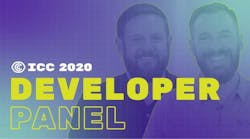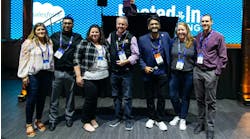Inductive Automation Developer Panel: What’s Next For Ignition?
Simplicity prompts engagement. That was at the core of the ICC 2020 event's Developer Panel, which featured Carl Gould, Inductive Automation director of software engineering, and Colby Clegg, VP of technology, and Paul Scott, training content manager, who moderated the discussion on what the company is about to release and what’s in store for users in the coming years.
Gould noted how Ignition 8.1 comes with a long-term support commitment, meaning that the Inductive team will provide support and updates for this product for the next five years. This is particularly attractive to more conservative customers, noted Clegg, with longer update cycles.
The duo explored some of the newest features of Ignition, including the Quick Start system that enables speedier adoption. “Quick Start is not just one thing, it has many different aspects,” explained Gould, highlighting new features developed to ensure a great first-time experience for those new to the software. “This lets you get going with Ignition as quickly as possible.”
The panel admitted that Ignition software can be difficult to describe. “We tell people to just download it and try it,” said Clegg. And blank templates can intimidate newcomers, which is why this 8.1 version includes pre-configured setups with tags provided in a reworked tag-browse tree, a local historian, a local database, a library of all components with examples of how each works, and other features intended to warm the welcome. “Think of it like we’re holding your hand as you get started launching projects.”
The progressive Workstation feature provides a dedicated desktop application for control-room operators featuring multi-monitor and full-screen kiosk modes. With the recognition that users bounce between workspaces within the tool, there is a focus on making that process more streamlined.
“So this is not just for mobile anymore, right?” asked the moderator. “Correct,” replied Clegg, who explained how the tool, increasingly being applied to incredibly large, complex projects, can work with native apps and different web browsers, various workstations and disparate channels. “This is the modern-day delivery method.”
Perspective Workstation is much more than a wrapper placed around a web browser, said Clegg. Within a web browser the user is at the mercy of the browser APIs. “When we're running inside of our own frame, we can do whatever we’d like,” said Gould.
How cool is that?
The audience for this panel was engaged, based on the questions they directed to the developers.
Are there trending components? Yes—The Power Chart feature addresses that.
Can the tool be configured at run time by the user? Yes—There are a host of run-time-accessible features.
Can all elements of the charts be reconfigured? Yes—There is the capability for users to perform multiple X-traces at once and there is built-in support for annotations.
Can we import transaction info into charts? Yes—We introduced a new historian-query source that enables you to browse databases and data sources, tables and more.
A new, sharper look
New HMI and symbol components are items of particular pride for the developers. “Our goal was to make things that actually look good,” said Clegg while displaying the sharp, customizable graphics within Ignition 8.1 that enable users to accurately replicate their assets—down to the piping elements—on the digital screen. “And it’s not complicated. We really want to elevate the process of creating HMI screens.”
The conversation then turned to the Vision Module within Ignition 8.1, and how this version update affects that module. “We definitely recognize that the majority of our customers have applications written in Vision,” said Gould, again referencing the five years of promised support for this module. Clegg added that 8.1 offers full support for IDP authentication, providing one modern solution for authentication across the board.
“The point is delivering tools that offer flexibility,” explained Clegg. “Ignition 8.1 is well-suited for this. It is platform-agnostic. It’s modular architecture lends itself to running instances that have their own purposes.”
Looking ahead
So what are some of the future possibilities for this team and the Ignition platform?
—Focusing on the testing infrastructure to make diagnostics easier.
—Exploring drivers and Ignition Perspective Module components that can be added without changing big parts of the core platform.
—Focusing on getting published performance benchmarks distributed to wider audiences to deepen their understanding of expectations of performance.
—Looking at all systems, internally from the support front door down to the lifecycle of how we prioritize features, to improve visibility for customers.
—Perhaps a new data historian...even a new approach to the practice. “When we talk about changes to our historian or next-gen historians, the discussion is often about ‘What is the tech you’re using to store time-series data?’” explained Gould. “What is more interesting and ripe for innovation is how historic data plays across the whole enterprise architecture.”
In a broad sense, the developers’ future is focused on making these tools as effective as possible for as many people to leverage as possible. Focusing on changes that improve reliability, stability and performance to promise a great user experience and working, constantly, toward making that a reality.
“This tool enables you to do things in the most straightforward, simple way possible,” summarized Gould as the panel wound to a close.
Clegg added an anecdote about a common criticism of the Ignition team that he hears from clients, who ask, “When are you going to slow down?” The VP of technology’s tone in relaying this question indicates—quite clearly—that he finds it to be more of a compliment.




